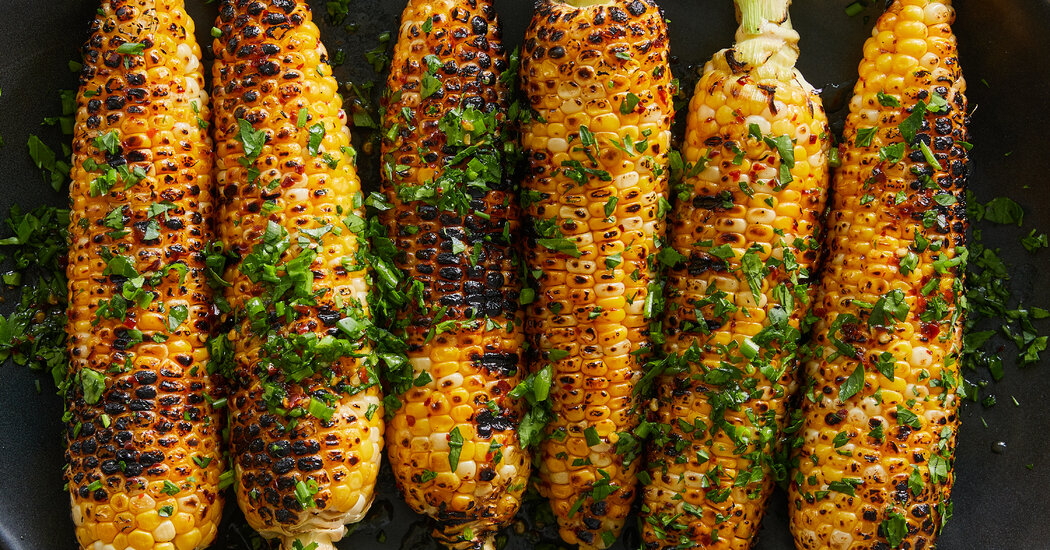
When cooking fresh sweet corn for one, nothing beats the microwave: A single ear, in its husk, goes in at full power for three minutes. The husk traps steam, giving the kernels such an intense corn flavor and juiciness that butter becomes nearly superfluous (nearly). But for a crowd? You have more options.
Take, for instance, the technique I stumbled on this summer, which is inspired by how I typically cook my hot dogs and sausages. First, I heat a grill, adjusting the gas or coals so that there’s a hot side and a cooler side. I grill my hot dogs over the direct heat to char them and then transfer them to an aluminum pan filled with sauerkraut (or other moist toppings) that I keep simmering on the cooler side of the grill, where they stay plump and juicy. This lets guests eat at their own pace (and avoids that lukewarm tray of wrinkly franks on the picnic table). The same technique — with a tray full of a salted honey-butter glaze in lieu of sauerkraut — works wonderfully for grilled corn.
I love this method for a few reasons. The first is flavor. One problem with sweet corn is that its sugar begins to transform into bland, mealy starch soon after the corn is harvested. This is an issue that scientists have been working on for over a century, identifying several gene mutations responsible for producing corn with significantly higher sugar content than typical field corn, as well as breeding varieties that hold onto their sugar longer. But even super-sweet modern varieties with names like Honey ’N Pearl or American Dream will start to lose sugar after a week or so in the fridge.
The same genes that give corn extra sweetness also reduce its ability to retain moisture: Sweet corn tends to dry out unless you eat it right after cooking or take measures to preserve its moisture. In side-by-side tests, I’ve found that the common advice to soak corn in a saltwater brine makes this shriveling only worse as kernels lose moisture through osmosis.
My cooking technique solves both of those issues. As the grilled corn sits in the simmering liquid (a mix of water, honey, butter and salt), getting turned occasionally, the moist cooking environment keeps the kernels plump and juicy. At the same time, the water in the pan evaporates slowly, reducing the honey and butter into a shiny glaze that enhances the corn’s natural sweetness without being cloying. Moreover, it buys you time to grill your burgers or asparagus on the now-freed-up hot side of the grill while the corn stays at temperature.
The honey-butter base is also widely adaptable. A pinch of smoky, mild gochugaru and a sprinkle of minced chives or parsley are simple complements to the honey, but there’s no need to stop there. You can whisk in few tablespoons of miso paste and a dash of soy sauce; add a mountain of minced fresh garlic and a tablespoon of Calabrian chile paste; stir in the zest and juice of a lemon and finish with a generous amount of coarsely ground black pepper. Or, you can flavor the glaze with a tablespoon of sambal oelek (or other fermented chile paste), a squeeze of lime and a shower of minced cilantro leaves. Any one of these combinations will enhance even supermarket corn that’s been sitting in the vegetable crisper since last Wednesday.
In a world optimized for flavor, I’d plant stalks of American Dream on April 17, so that their 78-day maturation period would coincide precisely with the Fourth of July. I’d have the grill ready and a crowd gathered in the garden just as the corn hits peak ripeness to minimize time between harvest, cooking and eating.
But, in the real world, I rely on smart, practical cooking techniques that guarantee delicious results, no matter how well I plan. If the corn is at peak ripeness, all the sweeter.
Recipe: Honey Butter Grilled Corn




